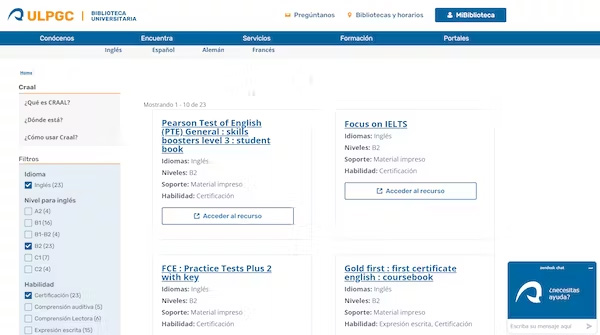
There are many reasons why we may find ourselves needing to demonstrate our knowledge of a foreign language: from aspiring for a job to being able to access certain titles, courses or scholarships. The most common and guaranteed way to do so is to obtain qualifications from the Official Language Schools (EOI), recognized at the national level. But what digital resources help to prepare official language exams? What do I need to know before applying?
Before you begin, you must identify your current level and the level at which you aspire to take the exam. Then find out the test format and practice, practice, practice – that is, write, speak, read and listen in that language.
What are the official exams
The official language accreditation exams respond to the descriptors of the Common European Framework of Reference for Languages (CEFR, Council of Europe, 2001, 2020). Six levels and three users are established. The six levels range from the most basic, A1, to the most proficient, C2.
The basic user (levels A1 and A2) understands and uses everyday and personal expressions and interacts easily as long as the interlocutor speaks slowly. The independent user (B1 and B2) is involved in more advanced texts and contexts with a more natural fluency. The competent user (C1 and C2) understands practically any type of text and expresses himself spontaneously and fluently in complex situations.
What are they for?
The most recent version of the CEFR ( 2020 in English , 2021 in Spanish ), continues to highlight, within its Language Policy program, the importance of diversity, multilingualism and language learning.
Having an official language accreditation is a motivation for students or professionals who want to access an international and intercultural context. It would be effective to combine autonomous learning, through digital resources, with face-to-face interactive and communicative learning. Multinational companies demand citizens who communicate in English with at least a B2. Of course, it adds to know other languages .
A common reference
The official exams guarantee communication skills and validate the language level of the student. Different associations of linguists, ACLES or Association of Language Centers in Higher Education in Spain; EALTA , ALTE or ILTA , at a European and international level, meet regularly to share good practices and advances in language accreditation.
In Spain, the ACLES and the Official Language Schools (EOI) summon and issue official certificates for the six levels. EOI exams are endorsed by the Ministry of Education and Vocational Training and are nationally recognized, while CertAcles exams are European recognized.
What format are the exams
The exam format is common. They are prepared to demonstrate language competence in the four language skills, modes or functions: oral and written expression, oral and written reception, interaction (with other users, with a multimedia text) and mediation (of concepts, of texts, of contexts).
Centers such as the French Alliance , the Goethe Institute or the Cervantes Institute offer their official DELF-DALF (French), Goethe-Zertifikat (German) and DELE (Spanish) exams all over the world.
Useful digital tools
Different digital tools facilitate the acquisition of the language and the training of the test to which you want to access. Frequent practice improves the communicative competence and the confidence of the apprentice to take the exam in time and form.
Let’s start with English, as an international lingua franca and for being the most demanded language in accreditation tests. In addition to informative guides or booklets , which describe the format of the test and how to prepare it, Cambridge English , for example, offers the resources: Speak & Improve and Write & Improve . With Speak & Improve, the Sandi robot will ask questions, ask the user to read and produce various speeches or describe images at a precise time. Depending on the answers, you will receive a report with a result and your level (B1, B2 or C1, for example), assessing fluency, intonation and pronunciation, and the vocabulary used in the speech. The user can listen to themselves, re-record themselves, and continue to interact with Sandi. It is based on artificial intelligence.
Write & Improve is also free and invites the candidate to write and improve their written production, receiving an evaluation and a level after each task completed. Other resources such as Englishaula.com offer exercises for the four skills of the language test, upon registration.
For different languages, PROCOMÚN is a network of Open Educational Resources (REA). It offers digital and multimedia material to practice different languages and at different educational levels.
In a similar vein, the Resource Center for Autonomous Language Learning (CRAAL) of the University of Las Palmas de Gran Canaria helps to filter information, selecting, for example, the language (English), the level (B2) and the skill to be strengthened (certification). As shown in the image, a wide number of print and digital resources are accessed.

CRAAL with 3 filters: English + B2 + Certification (ULPGC) Author provided
In addition, the ILTA association (International Language Testing Association) proposes a list of links to multimedia resources (videos, podcasts, scenarios or contexts…) for language preparation. Some are:
• French DALF/DELF Preparation Tests
• Spanish Tests free – Instituto Cervantes
• Self-Study Quizzes for EFL Students
• British Council: Online English Level Test
In the following table you can see some official language exams recognized by the ACLES and the Linguistic Boards of the CRUE . Many EOI and ACLES Centers offer their official exams in different languages and levels throughout Spain.
Constant practice and improvement
Learning languages is not a pending subject that is approved and that’s it. It is a transversal competence that is learned and improved throughout life. It constantly develops in different professional, educational and everyday fields.
It is possible at all ages , although early ages are preferable . Learning languages allows you to communicate, express, feel, listen and read, interact and mediate when faced with a message that is not well interpreted, either orally or in writing.
Author Bio: Soraya Garcia-Sanchez is Associate Professor of the Department of Modern Philology, Translation and Interpreting at the University of Las Palmas de Gran Canaria